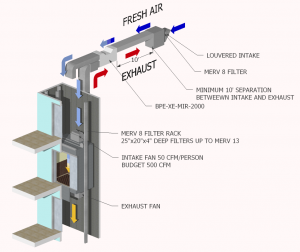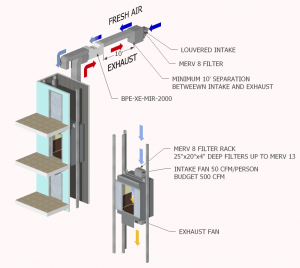
Sure, working remotely has its benefits, but many companies can’t wait to get back to the office. Many factors play a role as to when, but here’s a consideration not everyone thinks about: elevators. You could have an office perfect for social distancing, but what about the little box you ride to get there? You know Ed from accounting has no clue about personal space. Victoria? She loud talks wherever she is. Frank? That mask never covers his nose. And who wants to touch elevator buttons when studies have said there’s forty times more risky material on them than public toilet seats? Of course, apartment dwellers have suffered infection risk since the beginning of the pandemic. What rules and accommodations can we implement so folks can ride vertical transportation safely?
How risky is riding an elevator these days?
The risk involved in getting on an elevator during the pandemic varies according to scenario. How many floors are you traveling? Are people talking? Are they all wearing masks? How big is the car and how many are riding it? According to Dr. Richard Corsi, Dean of Engineering and Computer Science at Portland State University and an indoor air specialist, “…there are thousands of different scenarios that give different results.” Evaluating just one hypothetical scenario, Corsi suggests, “elevator cabin air may remain infectious for trips beyond infector exit.”
The bottom line is, you won’t know whether you’re joining a game of infection roulette on your way up or down. In the end, improving the odds involves a partnership between those who use the building and building management.
Make your elevator ride safer during the pandemic.
Use the same rules and common-sense tactics we’ve all heard ad nauseum for reducing your risk of viral infection: Wear that mask—even if alone, avoid touching anything (use knuckles, shirt sleeve, an inanimate object if you must), and distance yourself as is possible from others. If the doors open and someone isn’t wearing a mask, wait for the next car. In addition, don’t talk! This might sound tragic for some of us, but others can rejoice in not feeling pressured to make polite conversation. Hey, we take our silver linings where we can get them these days!
Building management tactics for reducing COVID-19 risks.
Building managers should act as leaders during the pandemic. Let occupants know you are on top of encouraging personal safety by providing signage about wearing masks, not talking, and limiting the number of elevator riders (experts often advise no more than four standing in corners.) Suggest using the stairs when possible, consider spacing out work start times and marking lobby floors to encourage social distancing in elevator lobbies.
From a mechanical standpoint, ASHRAE recommends facilities…
- Turn on cab ventilation fans where possible.
- Run elevators on a faster speed to minimize exposure time.
- Retrofit touchless buttons.
- Consider portable air cleaners with HEPA filters.
Elevator Mechanical Ventilation
In Corsi’s hypothetical model, a passenger entering a lift is exposed to approximately 25% of the viral particles left behind by the person leaving. Again, various factors can affect that percentage, such as the length of time the doors are open, the building’s varying air pressure, and the elevator ventilation system.
That ventilation system can make a huge difference. Building Performance Equipment, Inc. is of the opinion that indoor spaces don’t have to be stationary to benefit from an Energy Recovery Ventilator. CEO of BPE, Klas Haglid, P.E., backs a mechanical ventilation system solution (patent pending) where outdoor air is pushed down the elevator shaft by a nozzle and air velocity to constantly replace the air in the lift (see diagrams). Utilizing a building’s natural stacking effect, the stale air leaves the bottom of the lift and rides back up the shaft to expel outside. In larger buildings, with multiple elevator banks, one shaft could supply outdoor air and another could serve as the return. Several ERVs can serve taller buildings.
Superior Elevator Ventilation via a BPE-XE-MIR-2000 (stackable for larger buildings)
(Patent Pending)


Diagrams copyright © 1997-2020, BPE®, Inc.
Patent Pending
To discuss the ventilation needs of your elevator system, contact BPE, Inc. We are committed to making indoor life as safe and comfortable as possible during these challenging times through customized HVAC design solutions and our line of super energy-efficient ERVs.
